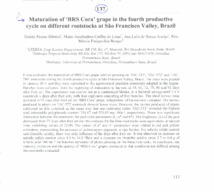Maturation of BRS Cora grape in the fourth productive cycle on different rootstocks at São Francisco Valley, Brazil.
Maturation of BRS Cora grape in the fourth productive cycle on different rootstocks at São Francisco Valley, Brazil.
Author(s): RIBEIRO, T. P.; LIMA, M. A. C. de; ARAÚJO, A. L. de S.; BORGES, R. M. E.
Summary: It was evaluated the maturation of BRS Cora grape cultivar growing on 'IAC-313', 'IAC-572' and 'IAC-766' rootstocks during the fourth productive cycle at São Francisco Valley, Brazil. The vines were pruned in January 2011 and they were submitted to the agronomical practices commonly adopted in the region. Bunches were collected from the beginning of maturation to harvest, at 58, 65, 72, 79, 86 and 92 days after fruit set. The experiment was carried out as a randomized blocks, in a factorial arrangement 3 x 6 (rootstock x days after fruit set), with four replicates consisting of five bunches. The ideal harvest time occurred at 92 days after fruit set for 'BRS Cora' grape, independent ofthe rootstock adopted. The berrics produced in plants on 'IAC-572' rootstock showed lower mass. However, the berries produced of plants cultivated on this rootstock as the same way that one cultivated under 'IAC-313' revealed the highest total extractable polyphenols content: 316.67 and 329,85 mg 1Oüg', respectively. There was significant interaction between the treatments for peel color parameters (L, a* and b*). The brightness (L) ofthe peel decreased from 72 days after fruit set and the averages for the three rootstocks were equivalents at harvest time, exhibiting values of 22.00. The values of a* and b* parameters were related to red and yellow coloration, representing the presence ofanthocianyns pigments in ripe berries. For soluble solids content and titratable acidity, there was only intluence of the days after fruit set. It was observed an increase on soluble solids content since 8.9 to 14.0 °Brix and a decrease on titratable acidity since 2.7 to 0.8 g of tartaric acid. I 00 mL-l for bunches harvested of plants growing on the three rootstocks. In conclusion, the maturity evolution and the quality of 'BRS Cora' grapes produced at that conditions not differed among the rootstocks evaluate.
Publication year: 2013
Types of publication: Abstract in annals or event proceedings
Unit: Embrapa Semi-arid Region
Keywords: BRS Cora, Grape, Grapes, Maturação, Porta Enxerto, Uva, Vale do São Francisco, Variedade
Observation
Some of Embrapa's publications are published as ePub files. To read them, use or download one of the following free software options to your computer or mobile device. Android: Google Play Books; IOS: iBooks; Windows and Linux: Calibre.
Access other publications
Access the Agricultural Research Database (BDPA) to consult Embrapa's full library collection and records.
Visit Embrapa Bookstore to purchase books and other publications sold by Embrapa.

